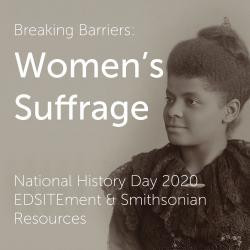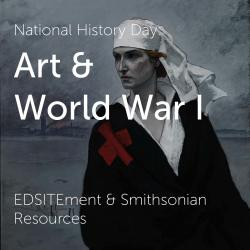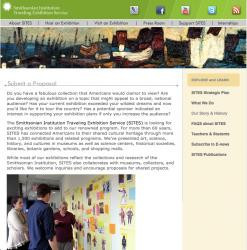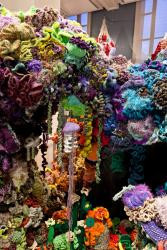Alison Leithner's collections
The Fight for Citizenship Rights: A Shared Legacy
<p>This is a topical collection concerning Civil Rights activism led by African Americans and Native Americans. The collection outlines the shifting approaches to activism, the different topics focused on, and the similarities between the struggle for African American and Native American citizenship rights. </p>
<p>#CivilRights #NativeRights #WoundedKnee #SCLC #WeShallOvercome #WoundedKnee #BlackPanther #AngelaDavis #AIM</p>
 Alison Leithner
Alison Leithner
52
Breaking Barriers: Women's Suffrage
<p>This collection brings together <a href="https://edsitement.neh.gov/">EDSITEment</a> and Smithsonian resources to support the initial research into a project for National History Day 2020, "Breaking Barriers in History."<br /></p>
<p>These resources—including photographs, objects, portraits, lesson plans, and articles—explore how women during the 19th and 20th centuries organized, petitioned, marched, and spoke out for the removal of barriers to full voting rights for women. While the 19th Amendment was passed in 1920, the extent to which this law led to equity for all women remains a point of debate. Resources address how groups and individuals sought to bring attention to the disenfranchisement of women, highlight the often overlooked perspectives and actions of women of color during the suffrage movement, and offer insight into the legacy of the suffrage movement on the larger fights for women’s and civil rights. The second resource of this collection contains questions to help with the analysis of a chosen topic alongside photograph, document, artwork, portrait, and object resources. </p>
<p>By no means is this collection comprehensive; instead, it provides a launching point for further research.</p>
<p>This collection was created in collaboration with the <a href="https://learninglab.si.edu/org/sclda">Smithsonian Center for Learning and Digital Access</a>.</p>
<p>Share your National History Day collections and let us know what you think! Write to us on Twitter: <a href="https://twitter.com/EDSITEment">@EDSITEment</a> and <a href="https://twitter.com/smithsonianlab">@SmithsonianLab</a>, #NHD2020. If you publish a collection on your National History Day topic, be sure to enter #NHD2020 in the description!</p>
<p>Tags: <em>voting, protest, African American, Mary Church Terrell, Ida B. Wells, Belva Ann Lockwood, Sojourner Truth, Mary McLeod Bethune, Anna Julia Cooper, Jeannette Pickering Rankin, Victoria Woodhull, Wyoming, Suffragette, Suffragist, Fannie Lou Hamer, Felisa Rincón de Gautier, Zitkala-Ša, Susette LaFlesche Tibbles, Alice Paul, ERA, civil rights, women’s rights, Edith Mayo, protest, boycott, twentieth century, 20th, #NHD</em></p><p></p>
<p></p>
 Alison Leithner
Alison Leithner
82
Portraits of James Baldwin
<p>This student activity begins with an analysis of two portraits of James Baldwin by different artists. Then, students are asked to create their own portrait of Baldwin by remixing source material from this collection. Student portraits should answer the following questions:</p>
<p>1. How do you think James Baldwin should be remembered?</p>
<p>2. What are Baldwin's contributions to American life and culture?</p>
<p>Students may need to do additional research on Baldwin and his life in order to complete this assessment. This is an opportunity for students to learn about and explore the life of a revolutionary writer who presents a unique view of the civil rights movement and status of African Americans in the United States.</p>
 Alison Leithner
Alison Leithner
25
Seeing, Thinking and Wondering About Living in Space
<p>Astronauts need food and good nutrition to stay healthy in space. This collection looks at the challenges in preparing, packaging, transporting, and storing food in space. What innovations were required? What problems needed to be solved? How did the problems change over time?<br /><br /><br />This collection uses the "See Think Wonder" visible thinking routine developed by Project Zero at Harvard University. This strategy encourages students to make careful observations and thoughtful interpretations. It helps stimulate curiosity and sets the stage for inquiry.<br /><br /><br />First, read through transcriptions of the storage lists from the Apollo 11 mission to space. Then, watch the Apollo 11 TV broadcast of July 22, 1969 of an astronaut eating in space (22 seconds). Use the "See Think Wonder" routine to stimulate interest among students about the problems encountered by astronauts when trying to eat. Ask, "What do you see? What do you think about that? What does it make you wonder?" Next, look at the second image in the collection, "Space Food, Meal Package, Day 11, Meal C, Apollo 11 (white)." Repeat the questions examining both the food and the label. <br /><br /><br />Next, ask students to search the collection for "space food" and assemble one meal -- breakfast, lunch or dinner. Compare the different meals created by students using the see, think, wonder routine. For example, what kinds of foods do they see (or not see)? How are the foods packaged and how does it change over time? How are the more recent foods different from the first meals? The purpose of this discussion is to help students see how engineering problems and solutions evolve over time. Ask students, what impact would longer missions have on packing meals for space?<br /><br /><br />Watch the video, "Three Types of Food," and compare the information in the video with student ideas. Then ask students to propose solutions for the current question -- "How can we grow food in space?" </p>
<p>Adapted from <a href="http://learninglab.si.edu/q/ll-c/rgu8u0Xt3KK238Tp" target="_blank">Seeing, Thinking, and Wondering About Food</a> by Stephanie Norby</p>
 Alison Leithner
Alison Leithner
6
Women in Flight
<p>Did you know that astronaut Mae Jemison carried a picture of aviator Bessie Coleman in her uniform pocket? Or that astronaut Sally Ride was a major supporter of vice presidential candidate Geraldine Ferraro? Find out about these inspirational women and others in this collection. This topical collection is a great starting point for research about female aviators and astronauts, and includes articles, images, artifacts, and video. Some guiding questions to consider might be:<br />-Why do you think it was so challenging for female pilots to become accepted? Compare the inclusion of women in aviation to other industries and fields. <br />-What role did the military play in the growth in the number of female aviators?<br />-What connections can you find between various female pilots and astronauts?<br />-Is being the "first" of something a political act? How do many female aviation leaders use their public voice?</p>
<p>#BecauseOfHerStory<br /></p><p>Adapted from <a href="https://learninglab.si.edu/collections/let-women-fly-female-aviators-and-astronauts/TJhqi1CMfNzms2rH#r" target="_blank">"Let Women Fly": Female Aviators and Astronauts</a> by Kate Harris</p>
 Alison Leithner
Alison Leithner
34
Photograph Analysis: Dorothea Lange's documentation of history through photographs
<p>In this collection, students will analyze a transcription of a letter from Dorothea Lange to painter Ben Shahn thanking him for capturing the "Biography of a Painting" in his new book. Students will then analyze several of Lange's works from the Great Depression and the incarceration of Japanese Americans during World War II and discuss the "biography of a photograph." How does the history of these photographs affect the impact they have? What elements of these photographs bring that history to life for the viewer?</p>
<p><br /></p>
 Alison Leithner
Alison Leithner
9
Smithsonian and the Twenty-First Century Museum: Leadership Strategies - Week 5 Images
<p>This collection supports the Week 5 lecture for the Harvard Extension School course MUSE E-200 Smithsonian and the Twenty-First Century Museum: Leadership Strategies. This fifth lecture is titled <em>The Business of Museums.</em></p><p>The course can be found on the Harvard Extension School's Canvas site at <a href="https://canvas.harvard.edu/courses/19789">https://canvas.harvard.edu/courses/19789</a></p><p>#MUSE200 #HES</p><p><br /></p>
 Alison Leithner
Alison Leithner
11
Smithsonian and the Twenty-First Century Museum: Leadership Strategies - Week 4 Images
<p>This collection supports the Week 2 lecture for the Harvard Extension School course MUSE E-200 Smithsonian and the Twenty-First Century Museum: Leadership Strategies. This fourth lecture is titled <em>Interdisciplinary Research and Collaboration Across an Institution. </em>The lecture features guest speaker, Liz Kirby.</p><p>The course can be found on the Harvard Extension School's Canvas site at <a href="https://canvas.harvard.edu/courses/19789">https://canvas.harvard.edu/courses/19789</a></p><p>#MUSE200 #HES</p>
 Alison Leithner
Alison Leithner
56
Smithsonian and the Twenty-First Century Museum: Leadership Strategies - Week 3 Images
<p>This collection supports the Week 2 lecture for the Harvard Extension School course MUSE E-200 Smithsonian and the Twenty-First Century Museum: Leadership Strategies. This third lecture is titled <em>Development of a Fundraising Plan for Museums and Smithsonian National Campaign.</em></p><p>The course can be found on the Harvard Extension School's Canvas site at <a href="https://canvas.harvard.edu/courses/19789">https://canvas.harvard.edu/courses/19789</a></p><p>#MUSE200 #HES</p>
 Alison Leithner
Alison Leithner
8












